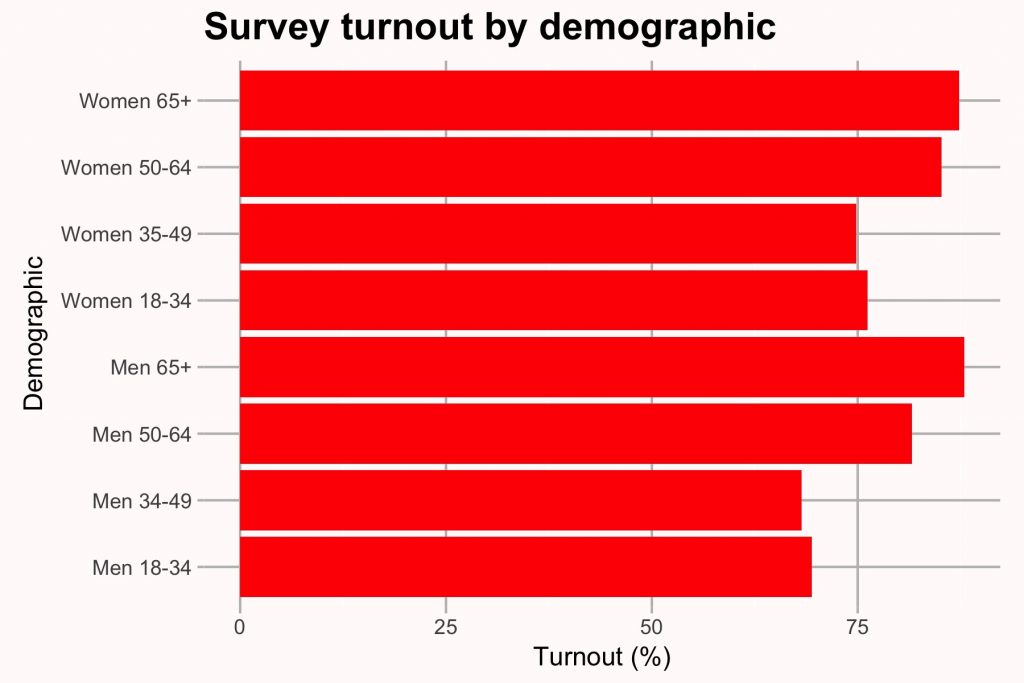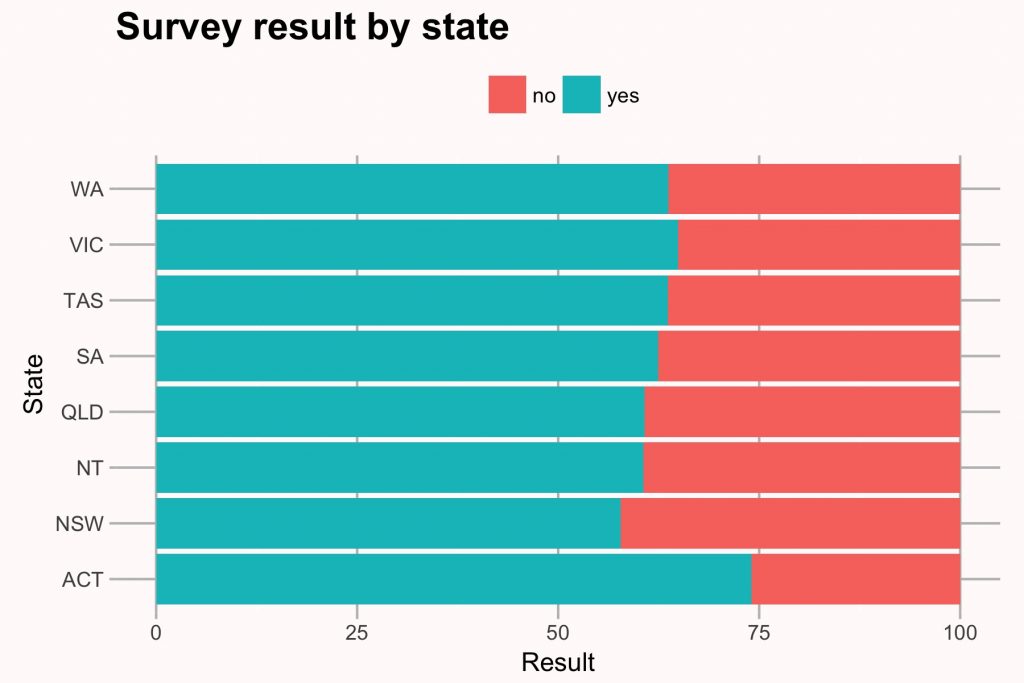11:41am – I won’t be making any more posts in this thread but I might come back later today with a summary.
10:54am – Eleven of the ‘no’ seats are held by Labor MPs. Five of the other six are held by the Coalition, and one is held by KAP.
10:45am – Here’s the breakdown of the turnout by demographic group:
Generally women were more likely to vote, and older people were more likely to vote.

10:39am – And here is my results map:
10:34am – The result was reasonably consistent across the country. The AEC classifies seats into four regional types. The vote was best in the inner metro, and worst in outer metro.
| State | Yes vote | Turnout |
| Inner Metropolitan | 65.68 | 81.17 |
| Outer Metropolitan | 58.46 | 79.32 |
| Provincial | 62.84 | 79.60 |
| Rural | 59.89 | 77.97 |
10:34am – And here’s the same info as a table:
| State | Yes vote | Turnout |
| ACT | 74.04 | 82.44 |
| NSW | 57.75 | 79.46 |
| NT | 60.57 | 58.37 |
| QLD | 60.74 | 77.92 |
| SA | 62.45 | 79.72 |
| TAS | 63.64 | 79.70 |
| VIC | 64.89 | 81.69 |
| WA | 63.74 | 78.45 |
10:28am – Here’s the yes vote by state.
The ACT voted about 74% in favour. NSW was the lowest state, with 57.8%. 12 of the 17 ‘no’ seats were in Sydney. Two were in Melbourne, three were in rural Queensland.
10:16am – The electorates which voted no are: Blaxland, Watson, McMahon, Werriwa, Fowler, Parramatta, Chifley, Calwell, Barton, Maranoa, Banks, Greenway, Kennedy, Bruce, Mitchell, Groom and Bennelong. Twelve of these seats are contiguous seats in western and southern Sydney.
10:02am – Turnout of 79.5%, approximately 12.7 million voters. All age groups had participation over 70%, slightly higher for older age groups. 78% of 18-19 year olds returned. Much lower turnout in the Northern Territory.10:04am – 61.6% of voters voted yes. Every state and territory recorded a yes result.
9:00am – Results will be announced in one hour, at 10am AEDT. I plan to download the data as quickly as possible and publish some interesting results as soon as possible, so please stay tuned right here.




Will be a most interesting morning … with widening implications …..
My federal MP has said he’ll vote in parliament on how the constituents in Petrie voted. This will be interesting we’ve got him on record saying that hopefully the constituents voted yes.
So, 61-62 percent Yes ….. with less than 38 percent No ….. not bad …. now PERHAPS the LNP will do their job on Parliament Hill and abide by the resut.
It would be interesting to now see the percentages of Islamic voters in the areas of NSW where the YES vote was weakest.
Interesting that the majority of “No” seats are urban, ethnically-diverse ones.
Only Maranoa, Groom and Kennedy fit the “rural One Nation White Christian Conservative” type mould that many people were probably expecting to vote no.
Instead it’s mostly the seats with high proportions of Muslims, Asians, and older European migrants.
It will be interesting to see the commentary on that.
The electorate breakdown is incredible really. All but five government seats returned a yes majority. Conversely, the biggest no votes were in staunchly Labor areas.
It highlights that the cultural divide we see amongst the political elite really doesn’t translate at the level of the ordinary voter. (Or to the extent that it does – especially in Sydney – it’s an inverse correlation!)
The distribution of the republic yes vote was similar. A generation later, not much has changed.
BC,
Not federally, but Antony Green did a summary of census statistics for the NSW 2015 election.
State seats with the highest proportion of Muslims are: Lakemba, Auburn, Bankstown, Granville, and Liverpool.
So essentially the federal seats of Watson, Blaxland, Parramatta, and Fowler.
Also, McMahon is where a lot of Italian Catholics live.
Ben, I love the map but can you take a second look a the colour scheme? In some cases it’s difficult to tell Yes from No. Groom and Bennelong, two weak No electorates, look identical in colour to neighbouring Yes electorates.
I think you’ve swapped the data for New England and Newcastle.
Thanks, New England/Newcastle and Lalor/La Trobe swapped around.
I added in a bright blue for no-voting seats.
That’s better. Thanks!
I have largely avoided commenting on this survey until now so I guess I could say whatever I want, but I did think Western Sydney would prove to be a bigger problem for Yes than rural seats.
Quite fascinating to see the breakdown of voting patterns. Surprised that the highest participation rates was in people over 65 years – even allowing for the fact that they know how to post a letter, its interesting. If younger people had been able to vote on line they probably would have managed to do it! Also glad Qld not disgraced – with NSW bringing in the lowest votes.
All the media coverage I’ve seen so far pins the result in western Sydney on a higher religious affiliation .. but surely that cannot be the whole (or even most) of the story? While some of the western Sydney electorates that voted no are noted for their higher than average religious affiliation, other electorates that voted no are not. And surely western Sydney is not the only area in the country with a marked religious affiliation? The Sydney electorates that voted no are those where right-wing talk back radio is the most popular (irrespective of political leanings) and the no vote was heavily promoted by that segment of the media. Perhaps the western Sydney result is nothing more than homophobia? I have lived most of my life in that area so it would not surprise me. No idea about the two Melbourne electorates that voted no. The Queensland ones .. predictable.
David Powell: Take a look at the plot at https://www.pollbludger.net/2017/11/15/sex-marriage-survey-61-6-yes-38-4-no/ and select “Secular/No Religion” in the dropdown. The correlation is pretty solid between that measure and ‘Yes’ proportion.
I’m not denying that correlation since it is solid, however it’s not perfect, so there are clearly other factors at play.
It could also be East Asians who aren’t necessarily that religious who are voting no too. not just Muslims.
Does Tony Abbott now vote yes to gay marriage, given how much his electorate supports it?
Comments are closed.